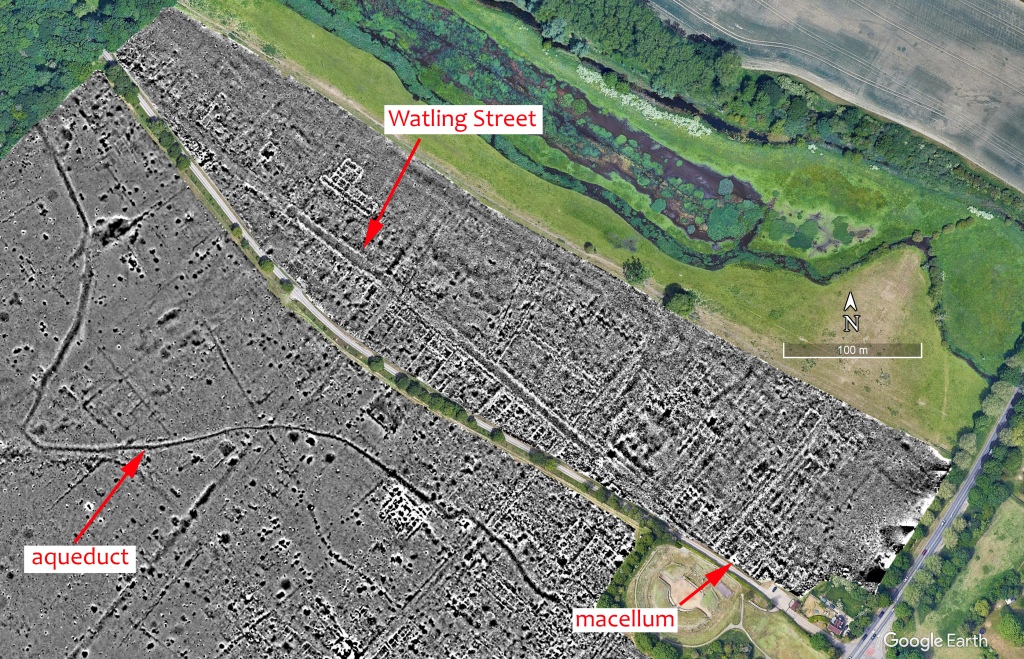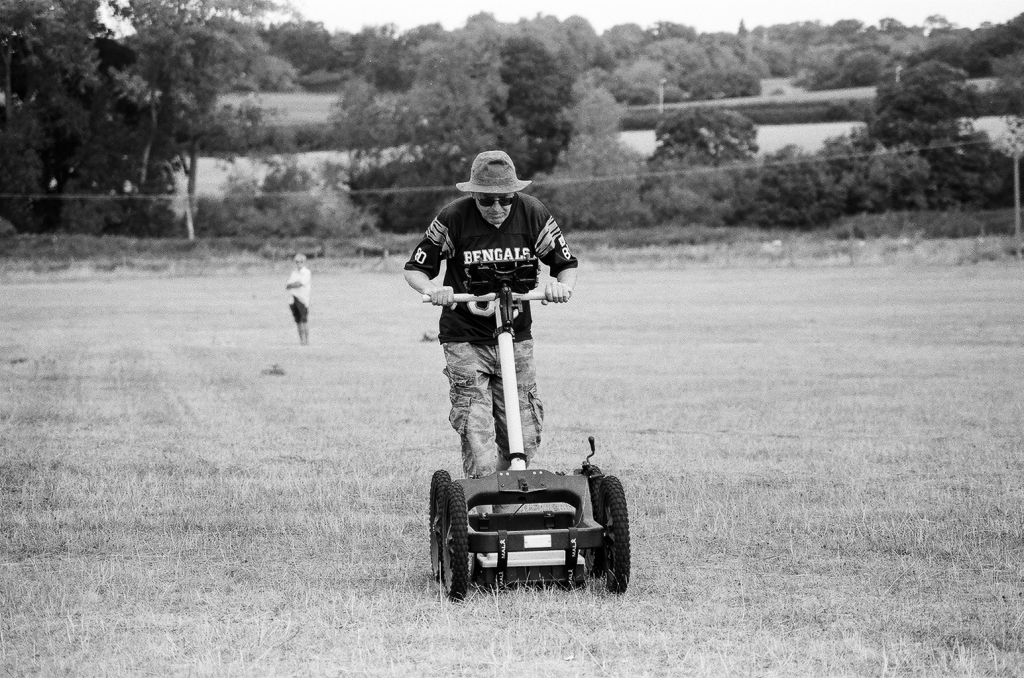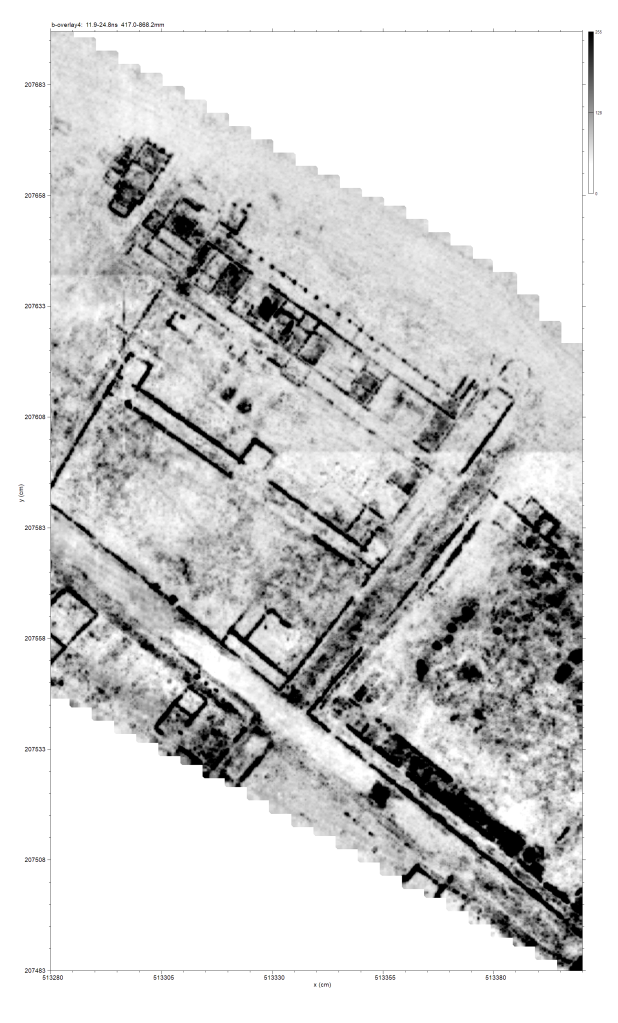Earlier in the year (16th/17th of February 2023 to be exact), members of CAGG along with students from UCL and staff from the Herts Historic Environment Record teamed-up to survey a transect across a field near Bygrave in the north of the county. The field had been surveyed before, and we were asked to look at a small section of it by the HHER for comparative purposes. I have written a detailed report which is available from the Hertfordshire planning portal and from my academia.edu pages.
The mag survey consisted of a transect across the field roughly 50m wide and 600m long. We were able to complete this within the two days using our new Sensys machine. I had plotted the centre point of the probable Bronze Age barrow and got the team to aim their transect to cut across it, which they did very nicely (Figure 1)!

Figure 2 shows the results from the mag survey. Due to the long length of the transect I’ve split it into three parts in Figures 3, 5 and 6.


In Figure 3 we can see two parallel lines running roughly north-south indicated with the red arrows. These were seen in the earlier survey and also in some of the Google Earth imagery. The most likely explanation is they indicate the line of the Roman road. In order to test if there might be buildings either side of the road we did a limited Earth Resistance survey (Fig. 4).

In Figure 4 I have overlain the Earth Resistance survey on the magnetometry. The left-hand image is from the survey with a 0.5m mobile probe separation. That survey is “looking” roughly 50cm below the surface. The two ditches show very well, and higher resistance readings between the ditches at the north end suggest some of the road make-up may survive. The readings decrease to the south and the ditches become less clear. This is probably because we are moving downslope and there is an increase in the depth of colluvium. The 1m probe spacing data on the right is less clear and more dominated by roughly east-west stripes. These are following the cultivation lines. I speculate that these are connected to cultivation, maybe deep ploughing?

The centre of the survey is less interesting (Fig. 5). The messy black and white blob in the middle is a modern ferrous feature. In some earlier Google Earth images the ploughing goes around it. There are two pipes going towards it (indicated by the blue arrows). The magnetic contrast in this field is very low. I have clipped the image to +/- 1.5nT. For comparison, the Verulamium surveys are often clipped to between +/-6nT and +/-9nT. The very slight “ripple” look in the block indicated by the yellow arrow is due to the operator having something ferrous on them at the time (car keys, wallet, phone in a pocket for example?). Although the cart is much more tolerant of the operator having something magnetic on them (after all, we have a giant battery on our backs!), it is not immune especially when we have to clip the data quite harshly as here.

At the eastern end the main feature is the ploughed out round barrow indicated by the yellow arrow. The upslope part is less clear probably because it was under a later field boundary that can be seen on the historic maps. The striping seen at the far end indicted by the red arrows are erosion channels in the relatively steep slope here. Just outside the survey area were a series of sand and gravels quarries shown on the historic OS maps.

On the second day we had just enough time to survey a single 20x20m Earth Resistance block over the barrow (Figure 7). Unfortunately, my plotting was a little too accurate and the survey was almost exactly inside the line of the barrow! It would be lovely to redo this at some point.

We were able to take some magnetic susceptibility readings on the second day (Fig. 8). The aim over the long term is to take some readings at the site of most of our mag surveys so we can build-up a data base of values compared to the “success” of the mag surveys as well as contributing to being able to interpret the wider geophysical surveys. Figure 9 shows the results.

The mag sus survey shows quite low contrast in readings going from 20 to 50 si units. The higher readings, however, do show the presence of the old field boundary which can be seen in the historic maps and the local relief model derived from the lidar data (Figure 10). The slight surviving bank from the field boundary was not at all obvious when walking around the field.

?Mode=survey on 2023-04-14.)
For more details on this survey, please consult the report linked above. One of the great things about working with CAGG is how it brings together quite mixed groups, in this case members of CAGG, students from UCL and the staff of the Herts HER. Many thanks go to Daniel Phillips for suggesting this survey and helping organise it. The team consisted of: Ruth Halliwell (CAGG), Jim West (CAGG), Graham Spurway (CAGG), Pauline
Hey (CAGG), Sarah Talks (CAGG), Daniel Phillips (HHER), Andy Instone (HHER),
Rebekah Hart (HHER), Greer Dewdney (HHER), Julia Rogers (UCL), Fiona Yuen Lam
Laii (UCL) and Charlotte Trudinger Charnley (UCL). We would also like to thank PACE
Jolt Energy Ltd, for facilitating access to the land.




























































